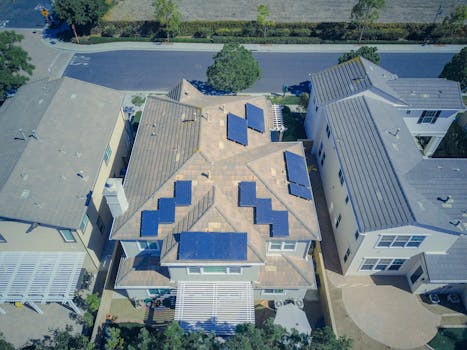“Empower Your Energy: The Ultimate Guide to Solar Inverter Systems.”
The Complete Guide to Solar Inverter Systems provides an in-depth exploration of the essential components and functionalities of solar inverter systems, which are crucial for converting solar energy into usable electricity. This guide covers various types of inverters, including string inverters, microinverters, and hybrid systems, detailing their advantages, applications, and installation considerations. It also addresses key topics such as efficiency ratings, grid connectivity, and the role of inverters in energy storage solutions. Whether you are a homeowner considering solar energy, a contractor, or an industry professional, this comprehensive resource equips you with the knowledge needed to make informed decisions about solar inverter systems and optimize your renewable energy investments.
Types Of Solar Inverter Systems
When considering the implementation of solar energy systems, understanding the various types of solar inverter systems is crucial for optimizing energy production and ensuring the longevity of the installation. Solar inverters play a pivotal role in converting the direct current (DC) generated by solar panels into alternating current (AC), which is the form of electricity used in homes and businesses. There are three primary types of solar inverter systems: string inverters, microinverters, and power optimizers, each with its unique advantages and applications.
String inverters are the most commonly used type of solar inverter, particularly in residential installations. This system connects multiple solar panels in a series, or “string,” to a single inverter. The simplicity of this design makes string inverters a cost-effective solution for many homeowners. However, one of the main drawbacks is that the performance of the entire string can be affected by the least efficient panel. For instance, if one panel is shaded or malfunctioning, it can reduce the output of the entire string. Despite this limitation, string inverters are often favored for their reliability and ease of installation, making them a popular choice for many solar energy projects.
In contrast, microinverters offer a more advanced solution by attaching a small inverter to each individual solar panel. This configuration allows each panel to operate independently, which means that shading or performance issues with one panel do not impact the others. As a result, microinverters can maximize energy production, particularly in installations where panels may be subject to varying degrees of sunlight due to obstructions like trees or buildings. Additionally, microinverters provide enhanced monitoring capabilities, allowing homeowners to track the performance of each panel individually. While they tend to be more expensive than string inverters, the increased efficiency and flexibility can make them a worthwhile investment for certain applications.
Power optimizers represent a hybrid approach, combining elements of both string inverters and microinverters. In this system, each solar panel is equipped with a power optimizer that conditions the DC electricity before sending it to a central string inverter. This setup allows for improved energy production similar to microinverters while maintaining the cost-effectiveness of string inverters. Power optimizers can mitigate the effects of shading and panel mismatch, making them an attractive option for installations with complex roof layouts or partial shading. Furthermore, they also offer monitoring capabilities, enabling users to assess the performance of individual panels.
As the solar industry continues to evolve, new technologies and innovations are emerging, leading to the development of additional inverter types, such as hybrid inverters. These systems can manage energy from both solar panels and battery storage, allowing for greater energy independence and efficiency. Hybrid inverters are particularly beneficial for homeowners looking to store excess energy generated during the day for use during peak demand times or at night.
In conclusion, selecting the right type of solar inverter system is essential for maximizing the efficiency and effectiveness of a solar energy installation. Each type—string inverters, microinverters, and power optimizers—offers distinct advantages and is suited to different scenarios. By understanding the characteristics and benefits of each system, homeowners and businesses can make informed decisions that align with their energy needs and financial goals. As solar technology continues to advance, staying informed about these options will empower users to harness the full potential of solar energy.
How To Choose The Right Solar Inverter

Choosing the right solar inverter is a critical step in the process of setting up a solar energy system, as it directly impacts the efficiency and performance of your solar panels. To begin with, it is essential to understand the different types of solar inverters available on the market. The three primary types are string inverters, microinverters, and power optimizers. String inverters are the most common and are typically used in residential installations. They connect multiple solar panels in a series, which means that the performance of the entire string can be affected by the least efficient panel. On the other hand, microinverters are installed on each individual panel, allowing for maximum energy production since each panel operates independently. Power optimizers, while not inverters themselves, work in conjunction with string inverters to enhance the performance of each panel, mitigating the effects of shading and other issues.
Once you have a grasp of the different types of inverters, the next step is to consider the size and capacity of the inverter. The inverter should be appropriately sized to match the output of your solar panel system. A common rule of thumb is to select an inverter that can handle about 80% of the total capacity of your solar panels. This approach helps to ensure that the inverter operates efficiently without being overloaded, while also allowing for some future expansion if you decide to add more panels later on. Additionally, it is crucial to evaluate the inverter’s efficiency rating, which indicates how well it converts the direct current (DC) generated by the solar panels into alternating current (AC) for use in your home. Look for inverters with high efficiency ratings, typically above 95%, as this will maximize the energy harvested from your solar system.
Moreover, the reliability and warranty of the inverter are significant factors to consider. Inverters are often the most vulnerable component of a solar energy system, and their lifespan can vary widely. Most reputable manufacturers offer warranties ranging from five to twenty years, so it is wise to choose an inverter with a longer warranty period. This not only provides peace of mind but also indicates the manufacturer’s confidence in their product’s durability. Furthermore, researching the brand’s reputation and customer reviews can provide valuable insights into the reliability and performance of their inverters.
In addition to these technical specifications, it is also important to consider the inverter’s features and compatibility with your solar energy system. For instance, some inverters come equipped with monitoring capabilities that allow you to track the performance of your solar panels in real-time. This feature can be particularly beneficial for identifying issues early on and ensuring that your system operates at peak efficiency. Additionally, if you plan to incorporate battery storage into your solar setup, ensure that the inverter you choose is compatible with battery systems, as this will allow for greater energy management and utilization.
Finally, consulting with a professional installer can provide personalized recommendations based on your specific energy needs and installation conditions. They can help you navigate the complexities of solar inverter systems and ensure that you make an informed decision. By taking the time to evaluate the various options and considering factors such as type, size, efficiency, reliability, and features, you can confidently select the right solar inverter that will optimize your solar energy system and contribute to a sustainable future.
Installation Process For Solar Inverter Systems
The installation process for solar inverter systems is a critical step in harnessing solar energy effectively. Understanding this process not only helps homeowners and businesses make informed decisions but also ensures that the system operates efficiently and safely. Initially, the installation begins with a thorough site assessment, where professionals evaluate the location for solar panel placement, considering factors such as roof orientation, shading from trees or buildings, and the overall structural integrity of the roof. This assessment is crucial because it determines the optimal configuration for the solar panels and the inverter system, ultimately influencing energy production.
Once the site assessment is complete, the next step involves selecting the appropriate solar inverter. There are various types of inverters available, including string inverters, microinverters, and power optimizers, each with its own advantages and disadvantages. String inverters are commonly used for residential systems due to their cost-effectiveness, while microinverters offer enhanced performance in shaded conditions. After selecting the inverter type, the installation team will prepare for the physical installation, which typically begins with mounting the solar panels on the roof or ground. This process requires careful attention to detail, as the panels must be securely fastened to withstand wind and other environmental factors.
Following the panel installation, the next phase involves connecting the solar panels to the inverter. This connection is crucial, as it allows the direct current (DC) generated by the solar panels to be converted into alternating current (AC), which is used by most household appliances. During this stage, the installation team will also set up the necessary wiring and electrical components, ensuring that all connections are secure and compliant with local electrical codes. It is essential to use high-quality materials and follow best practices to minimize the risk of electrical faults and maximize system longevity.
After the inverter is connected, the installation team will integrate the system with the existing electrical infrastructure. This step often involves connecting the inverter to the main electrical panel, which allows the solar energy produced to be used directly in the home or business. Additionally, if the system is designed to allow for net metering, the installation team will ensure that the appropriate meters are installed to track energy production and consumption accurately. This integration is a vital part of the process, as it enables homeowners to benefit from solar energy while still having access to grid power when needed.
Once the system is fully installed and connected, a comprehensive testing phase follows. This testing ensures that all components are functioning correctly and that the system is operating at peak efficiency. The installation team will check for any potential issues, such as wiring errors or performance discrepancies, and make necessary adjustments. After successful testing, the final step involves obtaining any required permits and inspections from local authorities. This step is essential for compliance with regulations and ensures that the system meets safety standards.
In conclusion, the installation process for solar inverter systems is a multifaceted endeavor that requires careful planning, skilled labor, and adherence to safety regulations. By understanding each step of the process, from site assessment to final inspection, homeowners and businesses can appreciate the complexity involved in setting up a solar energy system. Ultimately, a well-installed solar inverter system not only enhances energy efficiency but also contributes to a sustainable future.
Maintenance Tips For Solar Inverters
Maintaining solar inverter systems is crucial for ensuring their longevity and optimal performance. As the heart of a solar power system, inverters convert the direct current (DC) generated by solar panels into alternating current (AC) that can be used by household appliances or fed back into the grid. To keep these systems functioning efficiently, regular maintenance is essential. One of the first steps in maintaining a solar inverter is to conduct routine visual inspections. This involves checking for any signs of physical damage, such as cracks or corrosion, which can compromise the unit’s integrity. Additionally, it is important to ensure that the inverter is free from dust and debris, as these can obstruct airflow and lead to overheating.
Furthermore, monitoring the inverter’s performance is vital. Most modern inverters come equipped with monitoring systems that provide real-time data on energy production and system efficiency. By regularly reviewing this data, homeowners can identify any irregularities or drops in performance that may indicate a problem. If the inverter is not producing energy as expected, it may be time to investigate further. In some cases, a simple reset of the inverter can resolve minor issues, but persistent problems may require professional assistance.
Another critical aspect of maintenance involves checking the electrical connections. Over time, connections can become loose or corroded, which can lead to inefficiencies or even system failures. It is advisable to inspect these connections at least once a year, ensuring that all terminals are tight and free from corrosion. If any issues are detected, they should be addressed promptly to prevent further complications. Additionally, ensuring that the inverter is installed in a suitable environment is essential for its longevity. Inverters should be placed in a cool, dry location, away from direct sunlight and moisture. Excessive heat can lead to overheating, while moisture can cause electrical failures. Therefore, maintaining an appropriate environment is key to prolonging the life of the inverter.
Moreover, it is important to keep the inverter’s firmware up to date. Manufacturers often release updates that can enhance performance, improve efficiency, or address known issues. Regularly checking for and installing these updates can help ensure that the inverter operates at its best. Homeowners should also familiarize themselves with the warranty and service agreements provided by the manufacturer. Understanding the terms of these agreements can help in making informed decisions about maintenance and repairs, as well as knowing when to seek professional help.
In addition to these maintenance tips, it is wise to schedule periodic professional inspections. While many maintenance tasks can be performed by homeowners, having a qualified technician conduct a thorough inspection can uncover potential issues that may not be immediately apparent. These professionals can also provide valuable insights into the overall health of the solar power system and recommend any necessary repairs or upgrades.
In conclusion, maintaining solar inverter systems is a multifaceted process that requires attention to detail and proactive measures. By conducting regular visual inspections, monitoring performance, checking electrical connections, ensuring a suitable environment, keeping firmware updated, and scheduling professional inspections, homeowners can significantly enhance the efficiency and lifespan of their solar inverter systems. Ultimately, a well-maintained inverter not only maximizes energy production but also contributes to the overall sustainability and reliability of solar energy systems.
Q&A
1. **What is a solar inverter?**
A solar inverter is a device that converts the direct current (DC) generated by solar panels into alternating current (AC), which can be used to power home appliances and be fed into the electrical grid.
2. **What are the different types of solar inverters?**
The main types of solar inverters are string inverters, microinverters, and power optimizers. String inverters connect multiple solar panels in series, microinverters are installed on each panel individually, and power optimizers work with string inverters to maximize energy production.
3. **How do solar inverters impact energy efficiency?**
Solar inverters play a crucial role in energy efficiency by optimizing the conversion of solar energy to usable electricity, managing the output based on real-time conditions, and ensuring that the system operates at peak performance.
4. **What features should be considered when choosing a solar inverter?**
Key features to consider include efficiency rating, warranty period, monitoring capabilities, compatibility with solar panel systems, and safety certifications.
Conclusion
The complete guide to solar inverter systems provides a comprehensive understanding of the essential role in converting solar energy into usable electricity. It covers various types of inverters, their functionalities, installation processes, and maintenance requirements. By understanding the different inverter technologies, such as string inverters, microinverters, and power optimizers, users can make informed decisions that enhance the efficiency and reliability of their solar energy systems. Ultimately, a well-chosen solar inverter system is crucial for maximizing energy production, ensuring system longevity, and achieving a sustainable energy future.




